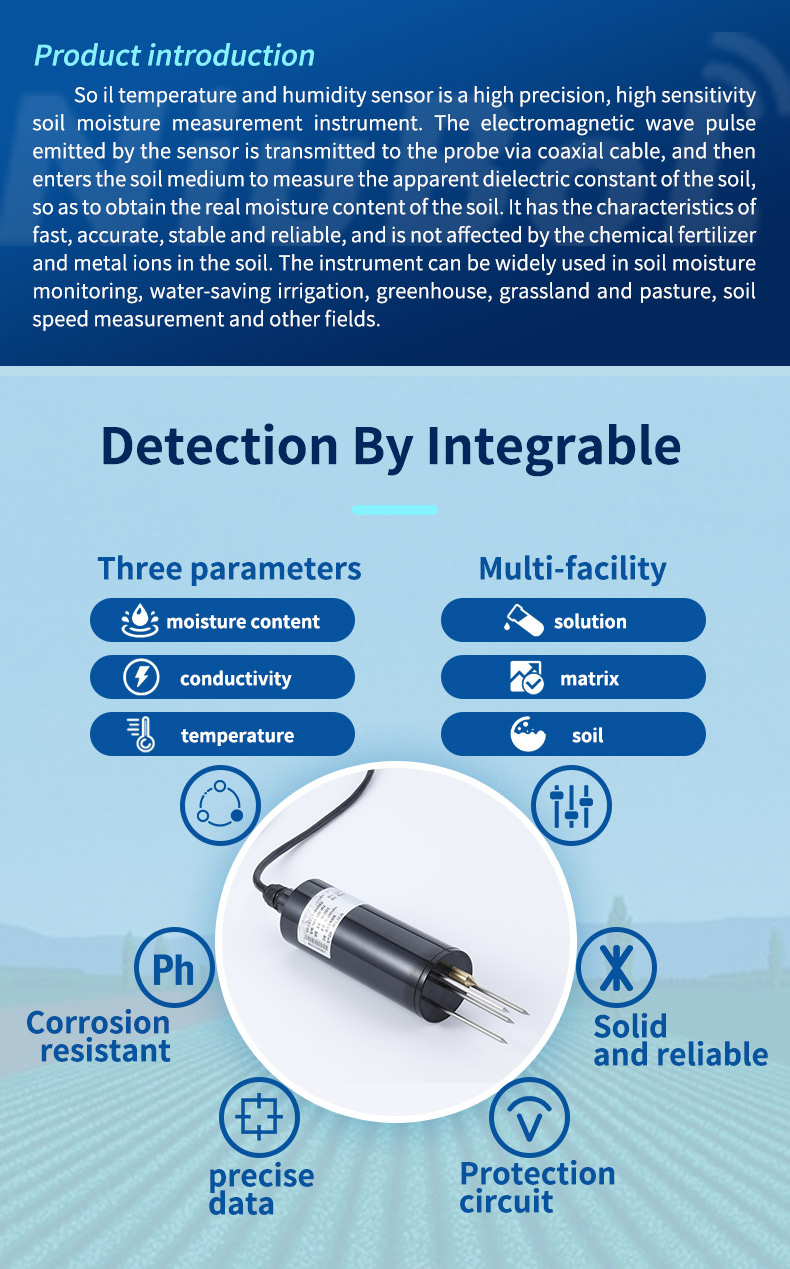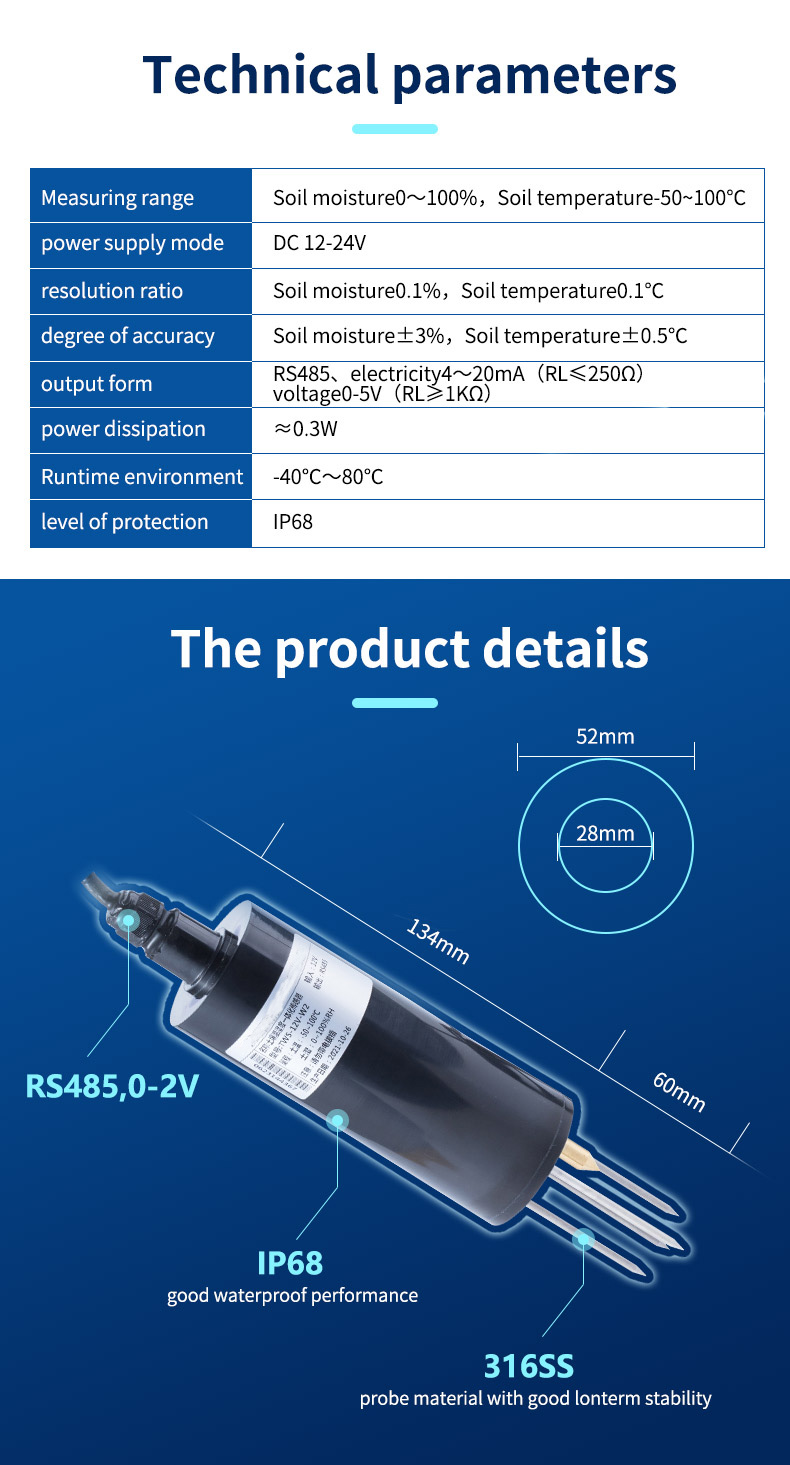

— Blogs —
—Products—
 Consumer hotline +8618073152920
Consumer hotline +8618073152920 WhatsApp:+8615367865107
Address:Room 102, District D, Houhu Industrial Park, Yuelu District, Changsha City, Hunan Province, China
Product knowledge
Time:2022-05-10 21:30:22 Popularity:2134
Soil Moisture Sensor Classification
After more than half a century of development, soil moisture sensors have come in many varieties and forms. The measurement of humidity has a certain complexity, and the well-known hair hygrometer, wet and dry bulb hygrometer, etc. can no longer meet the actual needs of modern requirements. Therefore, various soil moisture sensors have been developed. Humidity sensors can be generally divided into capacitive, resistive, ion sensitive, light intensity, and surface acoustic wave types according to their measurement principles.
1. Capacitive soil moisture sensor
The sensitive element of the capacitive soil moisture sensor is a humidity sensitive capacitor, and the main materials are generally metal oxides and high molecular polymers. These materials have strong adsorption capacity for water molecules, and the amount of adsorbed water varies with the change of ambient humidity.
Due to the large electric dipole moment of water molecules, the permittivity of the material changes after water absorption, and the capacitance value of the capacitor also changes. The change of capacitance value is converted into an electrical signal, and humidity can be monitored.

Humidity-sensitive capacitors are generally made of polymer film capacitors. When the ambient humidity changes, the dielectric constant of the humidity-sensitive capacitor changes, and its capacitance also changes. The amount of capacitance change is proportional to the relative humidity. This feature enables the measurement of humidity.
Commonly used capacitive soil moisture sensing media are: porous silicon, polyimide, in addition to polysulfone (PSF), polystyrene (PS), PMMA (linear, cross-linked, plasma polymerization).
2. Resistive soil moisture sensor
The sensitive element of the resistance type soil moisture sensor is a humidity sensitive resistor, and its main materials are generally dielectrics, semiconductors, porous ceramics, etc. These materials have strong adsorption to water, and the resistivity/conductivity will change with the change of humidity after absorbing water, so the change of humidity can lead to the change of the resistance value of the hygroscopic resistor, and the change of the resistance value can be converted into the required electricity. Signal.

For example, an aqueous solution of lithium chloride forms a film on the substrate. With the increase or decrease of the water vapor content in the air, the film absorbs moisture and dehumidifies, the concentration of salt in the solution decreases and increases, and the resistivity increases and decreases accordingly. , the resistance between the two stages increases and decreases. Another example is the porous ceramic humidity sensitive resistor. The ceramic itself is composed of many small crystal particles. Most of the pores are connected to the outside world. Water molecules can be adsorbed through the pores, causing changes in ion concentration, resulting in changes in resistance between the two electrodes.
3. Ionic soil moisture sensor
Ion-sensitive field-effect transistors (ISFETs) belong to semiconductor biosensors, which were developed in the 1970s by P. Invented by Bergeld. The ISFET directly contacts the ion buffer solution in the measured solution through different sensitive thin film materials on the gate, and then the ion concentration in the solution can be measured.
Ion sensitive device by. The ion selective membrane (sensitive membrane) and the converter are composed of two parts. The sensitive membrane is used to identify the type and concentration of ions, and the converter converts the information sensed by the sensitive membrane into electrical signals. The ion-sensing field effect transistor is made of a layer of sensitive film on the insulating gate, and different kinds of ions detected by different sensitive films are also different, so that they have ion selectivity.
Related recommendations
Sensors & Weather Stations Catalog
Agriculture Sensors and Weather Stations Catalog-NiuBoL.pdf
Weather Stations Catalog-NiuBoL.pdf
Related products
 Combined air temperature and relative humidity sensor
Combined air temperature and relative humidity sensor Soil Moisture Temperature sensor for irrigation
Soil Moisture Temperature sensor for irrigation Soil pH sensor RS485 soil Testing instrument soil ph meter for agriculture
Soil pH sensor RS485 soil Testing instrument soil ph meter for agriculture Wind Speed sensor Output Modbus/RS485/Analog/0-5V/4-20mA
Wind Speed sensor Output Modbus/RS485/Analog/0-5V/4-20mA Tipping bucket rain gauge for weather monitoring auto rainfall sensor RS485/Outdoor/stainless steel
Tipping bucket rain gauge for weather monitoring auto rainfall sensor RS485/Outdoor/stainless steel Pyranometer Solar Radiation Sensor 4-20mA/RS485
Pyranometer Solar Radiation Sensor 4-20mA/RS485
Screenshot, WhatsApp to identify the QR code
WhatsApp number:+8615367865107
(Click on WhatsApp to copy and add friends)
